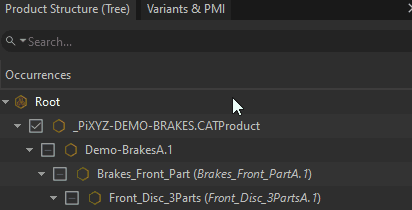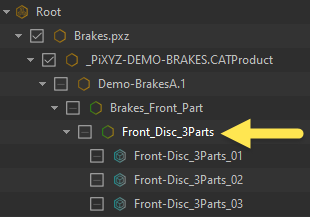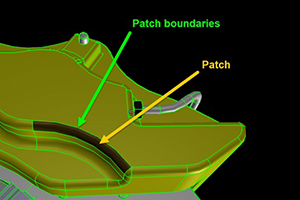Glossary
| Item | Description |
|---|---|
| Entity | An entity is the Pixyz API base object. All objects manipulated in Pixyz are derived from Entity (a part, a material, a texture… is an entity). See Scripting With the Python API |
| Product structure (tree) | In Pixyz vocabulary, the Product Structure designates the scene tree, or scene hierarchy. |
| Tree level | The tree level (used in functions Merge Final Level and Merge By Tree Level) designates the level at which an occurrence is positioned in the Product Structure. The Root node is Level 0. |
| Final level | In Pixyz, a final Level (used in function Merge Final Level) designates an Assembly node (see below) whose children are exclusively part occurrences. |
| Node | A node is a single element of the Product Structure, more commonly called an occurrence in Pixyz vocabulary. |
| Occurrence | In Pixyz Studio, an occurrence is the fundamental object of a scene's Product Structure, and is similar to the GameObject concept in Unity. Each node of the Tree is an occurrence. See About the Product Structure (Tree) |
| Part occurrence | An occurrence with a part component is a part occurrence, more commonly called part. Basically, a part is any object containing geometry that can be selected individually in a scene (from the viewport, or using Python scripting). See Occurrence Types |
| Part | A part commonly designates a part occurrence in Pixyz vocabulary. It can also designate a part component in the Python API. |
| Assembly | An occurrence with no part component, and having other occurrences as children, is called an Assembly occurrence, or assembly.See Occurrence Types |
| Instance | An instance is an occurrence that is duplicated multiple times across a scene, In Pixyz, instantiation is managed through a concept called prototype. See About Instances & Prototypes |
| Component | An occurrence can receive components to modulate its behavior (just like in Unity). See About Occurrence Components |
| Prototype | A prototype is an occurrence that can be referenced by other occurrences, allowing to create instantiation behavior. Occurrences pointing to a prototype are instances. See About Instances & Prototypes |
| Empty | The term empty (used for example in the function Delete Empty Occurrences) is associated with an occurrence containing no geometry (no part component or a part component containing no geometry), no light (no Light component) and having no children. |
| Metadata | Metadata is non-geometric data that can be carried by a Product Structure occurrence, which was added by engineering for multiple possible reasons: design information, manufacturing information, logistic information… |
| Geometry | A geometry is a collection of shapes. It can either be a CAD geometry (BRep shapes) or a Mesh geometry (Tessellated shapes). See About 3D Models Types |
| BRep | BRep is the kind of geometry retrieved when importing a native CAD file in Pixyz. It is also called CAD geometry or precise geometry. In Studio's GUI, both BRep and CAD terminologies can be used, but they both refer to the same kind of geometries. See definition on Wikipedia |
| BRep shape | In Pixyz, a BRep shape contains BRep geometrical information like surfaces (or volumes), curves and points (themselves defined by faces, edges and vertices). |
| Patch | A patch is a CAD face or surface limited by spline curves. |
| Patch boundary | A patch boundary (or patch border) is a non-discontinuous patch border or edge: |
| Mesh | See definition on Wikipedia |
| Connected mesh | A connected mesh is a separate mesh element within a Part. Think about 2 cubes merged together in one Part: each separate cube is a connected mesh |
| Tessellation | In surface modeling and solid modeling, tessellation is the method used to represent 3D objects as a collection of triangles or other polygons. All surfaces, both curved and straight, are turned into triangles either at the time they are first created or in real time when they are rendered. The more triangles used to represent a surface, the more realistic the rendering, but the more computation is required. See About Tessellation |
| Tessellated shape | In Pixyz, a tessellated Shape can contain meshes, free edges (a collection of connected free edges define a polyline, or curve) and free vertices. |
| Bounding box (BBox) | See definition on Wikipedia |
| Axis-aligned bounding box (AABB) | See definition on Wikipedia |
| Oriented bounding box (OBB) | See definition on Wikipedia |
| Minimum bounding box (MBB) | See definition on Wikipedia |